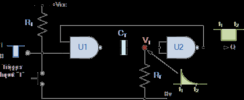The problem with simple cmos gate oscillators or 555 timer is accuracy
of pulse width and T & V effects. If you dont care about fact electrolytic
caps have wide tolerance range or variations (without pot trimming) of
50+ % then use those. Notice the tolerance column in this selector tool :
115,000+ capacitors all with those crappy tolerances.......
And not to ignore add on to this variation in cmos of gate threshold wide
range device to device, in case your design is not a one-off.
Otherwise use ones where IC is trimmed in production to give you accurate
results, like todays processors and their onchip clocks. Or even better the
Nano type of board where an xtal determines timing accuracy.
Lastly processors have better control over power on glitches, eg. proper design
will have none of those unwanted unpredictable pulses on their outputs when
power is ramping up or down.
Again processors have largely eliminated that problem.'
Regards Dana.



